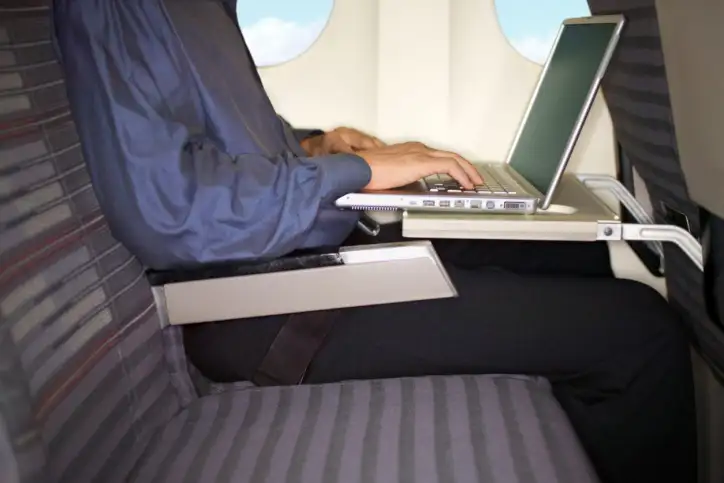
Airborne Wi-Fi is something of a paradox. Airlines around the world are gearing up to provide it, but according to recent reports, fewer than 10 percent of you actually use it on flights where it’s available. Although you’re carrying increasing numbers of smartphones, iPads, and laptops, you tend to complain about low bandwidth and high prices. And both coverage and pricing are evolving.
Probably the top news is that Wi-Fi is going international. The currently dominant system in the United States, Gogo from Aircell, uses lots of low-power ground transceivers to provide connectivity on Air Canada (transborder flights), Airtran (all aircraft), Alaska (most mainline aircraft), American (767-200s, some MD80s and 737s), Delta (most domestic aircraft types, but not international), Frontier (all mainline planes), United (PS transcon flights only), US Airways (all A321s), and Virgin American (all aircraft). Currently, Gogo is confined to mainland United States and Alaska, plus a few parts of Canada within range of U.S. stations, but Gogo recently announced full expansion into Canada. Most of these lines are completing fleetwide installations as soon as possible, at least on planes they intend to keep for more than a few years.
Ground stations, of course, don’t work very well for transoceanic flights, so airlines that want to offer Wi-Fi on long-haul intercontinental flights are turning to satellite-based services. Several companies, including Panasonic, OnAir (partially owned byAirbus), and Row 44 are equipping airlines with satellite services. Even though it’s not currently an overwater line, Southwest opted for satellite from the beginning, and now has many of its planes equipped. JetBlue has announced it will adopt a satellite system, and United will apparently standardize on satellite for a planned roll-out of fleetwide Wi-Fi. Many of the top international lines are adding satellite services. Not to be caught behind the tech curve, Gogo just announced it will partner with a satellite provider to offer a combination of ground-based and satellite services.
Bandwidth limitations still hurt. Typical airborne Wi-Fi systems do not offer the same speeds and bandwidth that you’re used to through cable or DSL. Gogo, for example, says it doesn’t handle streaming video. And even for less demanding tasks, many published reports indicate that speeds suffer significantly when a large percentage of a flight’s passengers use Wi-Fi. The jury is still out on whether satellite systems can do a lot better, but satellites have always been limited in upload speeds. So far, systems in domestic flights allow smartphone use for data and texting but not for voice, maybe to avoid problems with the “no cellphone” rules rather than bandwidth.
Suppliers are tweaking the pricing. Originally, Gogo mounted a standard online pricing menu for all airlines, ranging from a fixed price per flight to all-day and monthly “passes.” Recently, however, Gogo has experimented with per-hour pricing on some flights. The idea is to use higher prices to limit excessive bandwidth and lower prices to lure more customers when bandwidth use is low. Don’t expect to see this tweaking to stop anytime soon.
You can easily find flights with Wi-Fi. Airlines generally display Wi-Fi availability on each flight in their fare/schedule displays, and CheapAir and Hipmunk include Wi-Fi availability in their initial fare and schedule displays.
One way or another, you can expect to find onboard Wi-Fi on almost all big-line domestic flights within a few years and also on many intercontinental flights. Domestically, the main holdout is Hawaiian, but I’d expect it to go for a satellite-based system sooner rather than later. The future for Allegiant, Spirit, and Sun Country is a bit cloudier. Normally, these lines shun additional costs, which Wi-Fi entails, but if they see a chance for another fee stream, they might well bite. And you can expect onboard Wi-Fi to be widely available on foreign lines that fly to/from the United States and Canada.
Ed Perkins on Travel is copyright (c) 2012 Tribune Media Services, Inc.
You Might Also Like:
We hand-pick everything we recommend and select items through testing and reviews. Some products are sent to us free of charge with no incentive to offer a favorable review. We offer our unbiased opinions and do not accept compensation to review products. All items are in stock and prices are accurate at the time of publication. If you buy something through our links, we may earn a commission.
Related
Top Fares From
Today's Top Travel Deals
Brought to you by ShermansTravel
Kenya: 14-Night Tour, Incl. Tanzania &...
smarTours
 vacation
$7125+
vacation
$7125+
7-Night Caribbean Round-Trip Cruise From Orlando:...
Norwegian Cruise Line
 cruise
$739+
cruise
$739+
Ohio: Daily Car Rentals from Cincinnati
85OFF.com
 Car Rental
$19+
Car Rental
$19+



